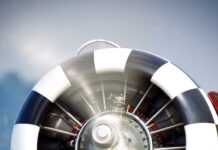Any pilot circling parachute jumpers at a public air show in the United States must have a “circle the jumpers” endorsement on his/her statement of aerobatic competency. But the most effective way to keep this aspect of the air show safe is to brief properly and thoroughly. A few key points for the briefing:
- How many jumpers will there be? Late additions are not permitted. Unavoidable changes must be communicated to everybody involved and especially the pilot(s) of the circling aircraft or the mission should be canceled. In the recent history of air shows, there have been two fatalities and at least one very close call because the number of jumpers exiting the jump platform was one more than the number agreed upon at the briefing.
- Does the pilot have the necessary statement of aerobatic competency card endorsement to circle the jumpers?
- How will wind conditions impact the planned parachute jump, including plans to have an aircraft circle the jumpers under canopy?
- If multiple aircraft are circling the jumpers, how will they arrive in the aerobatic box to begin circling the jumpers? Loose trail? In formation? Do the pilots have the necessary endorsements to fly in non-aerobatic formation? Where will they hold while the jumpers exit the jump plane?
- At what altitude will the jumpers exit the jump airplane? In what direction will the aircraft be flying when the jumpers exit the airplane? Will the pilot of the jump airplane give a radio call to the pilot(s) of the circling aircraft when the jumpers are about to exit the aircraft?
- At what altitude will the jumpers deploy their chutes? At what altitude will the aircraft begin circling the jumpers? How much higher than the highest jumper will the aircraft fly while circling the jumpers? What will be the minimum separation distances (vertical and horizontal) between the highest jumper and the lowest circling aircraft?
- Who calls the aircraft in to begin circling the jumpers? The air boss? One of the pilots in the aircraft that will be circling the jumpers?
- Generally, what kind of diameter will the aircraft fly while circling the jumpers? A low G pull that paints a very wide circle of smoke in the sky around the jumpers or a more aggressive pull and a smaller circle?
- At what altitude will the aircraft stop circling the jumpers? When they’ve stopped circling the jumpers, in which direction will the aircraft depart the aerobatic box? Where will the aircraft go after they’ve departed the aerobatic box? When will they land? Who will tell them when the jumpers are down and they can land?
- Does the circling aircraft have radio contact with the pilot of the jump plane? Will the jump plane pilot tell the circling pilot how many jumpers are going to be exiting?








